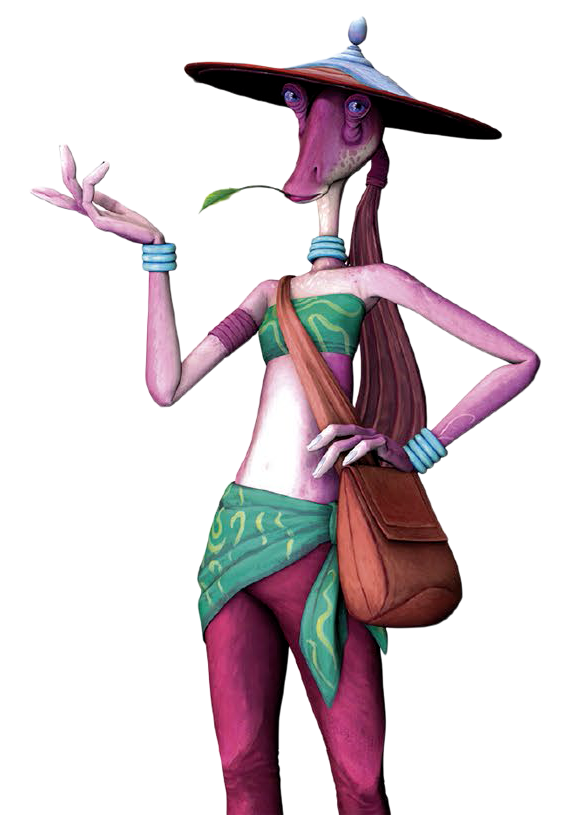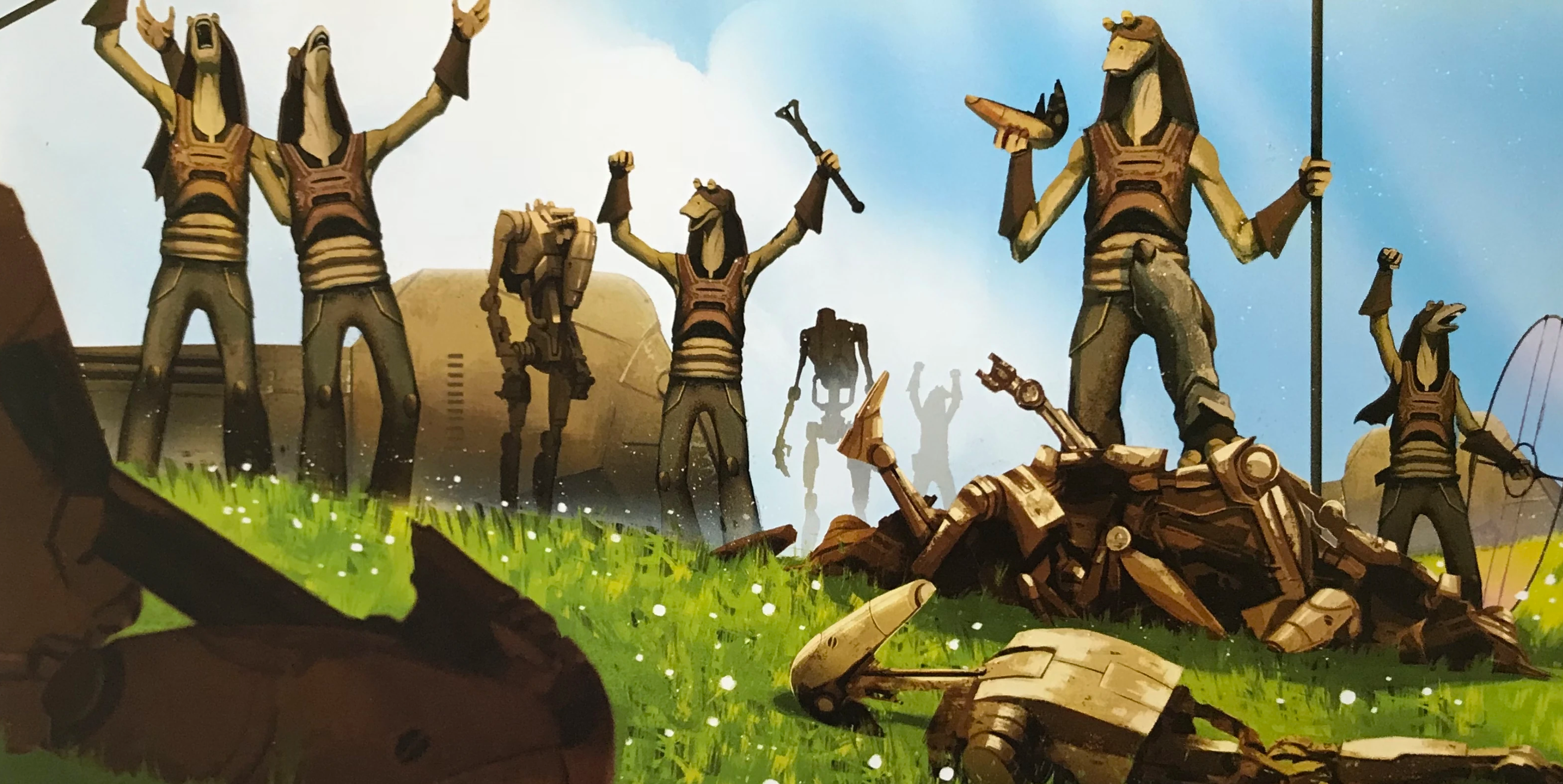Gungans were an amphibious sentient species and the indigenous inhabitants of the planet Naboo. The various different Gungan races could live on both water and land, but often made their home in underwater cities such as Otoh Gunga. Physically, Gungans were tall humanoids with a flexible structure, strong leg muscles, strong bills, muscular tongues, and many other traits designed for living in the waters of Naboo. They had strong accents when speaking in Galactic Basic Standard. Gungans were also known to rarely leave Naboo.
The Gungans had a tense and uneasy relationship with the non-native human Naboo people until the Trade Federation invasion. As a result of the invasion, the Gungans joined forces with the Naboo to expel the Trade Federation from their homeworld. Following the invasion, Jar Jar Binks would become the Junior Representative of the Gungan people in the Galactic Senate, serving alongside Senator Padmé Amidala of the Naboo.

Peppi Bow, a female Gungan shaak herder
The Gungans were a sentient amphibious species. They were tall humanoids with a flexible structure and strong leg muscles which allowed them to live in the waters of Naboo. Although Gungans' lives revolved around water, they did not need it to thrive and could settle far from it. Indeed, they could move between land and water without difficulty. Although their native water was the fresh waters of Naboo, they were able to survive in salt water, such as the seas of Mon Cala.
Born as tadpoles, Gungan infants developed limbs within months of being hatched. Accordingly, younglings would have to learn how to walk at an early age, after they learned how to swim with legs. Equipped with hardy lungs, they were capable of holding their breath for extended periods of time. Their body produced a mucus with waterproofing properties that assisted them when moving through water and they were capable of spitting it over a distance with great force, even when underwater. Their skeletal structure was extremely flexible, as it was made of cartilaginous material rather than hard bone. The long Gungan face had a tough yet flexible bill for burrowing and rooting out food. Some Gungans, such as Roos Tarpals, had whiskers on their bills. These whiskers were signs of maturity among Gungans. They had long muscular tongues with which they could scoop mollusks and lesser amphibians from the Naboo swamps, which they were comfortable eating raw.
There were two Gungan races: the lanky Otolla, who sported prominent bills and eyes set on short stalks, and the heavier Ankura, whose eyes were hooded. The Gungan earlobes called haillu, were most prominent in the Otolla.

Gungans played a large role in the Battle of Naboo
The Gungan species originated on the Mid Rim world of Naboo, which they shared with a human civilization known as the Naboo. During the High Republic Era, a Gungan scientist named Thaddeus Wolk was considered a leader in the field of theoretical hyperspace physics and taught Chancey Yarrow at the Academy of Carida until she got kicked out for theorizing about the creation of an artificial gravity well projector which she eventually designed for use by the Nihil. Determined to stop Yarrow from creating the gravity well projector, Wolk was assassinated on Coruscant before he could try to stop her.
Relations between the Gungans and the Naboo were tense until the Trade Federation invasion of Naboo. One Gungan exile named Jar Jar Binks befriended the Naboo Queen Padmé Amidala and convinced her to seek the help of the Gungans. Amidala succeeded in winning over the Gungan ruler Boss Nass and the two peoples formed an alliance to drive out the Trade Federation. During the Battle of Naboo, the Gungan Grand Army confronted the Federation's droid army outside Theed, which enabled Amidala's forces to seize back the capital and capture the Trade Federation's Viceroy Nute Gunray. After the invasion established positive relations between the Gungans and the Naboo, the Gungans were given the right to cast votes in the planet's elections.
During the Separatist Crisis, Jar Jar Binks served as the Junior Representative of the Gungan people in the Galactic Senate. He played an important role in supporting legislation which led to the creation of a Grand Army of the Republic. The Gungans remained loyal to the Galactic Republic during the Clone Wars. Gungan forces took part in the Battle of Mon Cala and assisted Prince Lee-Char's Mon Calamari forces and Republic allies against Separatist forces and their Quarren allies.

Rish Loo and Boss Lyonie during the Clone Wars
As the Clone Wars escalated, growing tensions between the Gungans and the Naboo were fueled by rumors that the Gungans were planning to aid a Separatist invasion of Naboo. Under the influence of his pro-Separatist adviser Rish Loo, the reigning Boss Lyonie ordered the Gungan Grand Army to march on Theed in a coordinated strike with a Separatist Droid Army led by General Grievous. However, Binks, with the help of Senator Amidala and Anakin Skywalker, succeeded in exposing Rish Loo's conspiracy. Unfortunately, Rish Loo wounded Lyonie before he could call off the attack. Binks then impersonated Lyonie and ordered the Grand Army to abort their assault on Theed. Gungan forces led by Roos Tarpals also played a role in capturing Grievous but were forced to release him after Count Dooku threatened to kill Skywalker.
Following the Battle of Endor, the Gungans confirmed the presence of typhoon-strength storms all over Naboo. These storms were created by several climate disruption array satellites deployed by the Imperial-class Star Destroyer Torment as part of Operation: Cinder, a secret Imperial plan to scour Naboo and several worlds. Before the Imperials could render Naboo uninhabitable, a New Republic fleet arrived and destroyed the Imperial forces; saving the planet.
Around the year 9 ABY, during a mission to rescue the Twi'lek Qin from a New Republic Correctional Transport, the criminal Migs Mayfeld mocked his associate Din Djarin, a Mandalorian bounty hunter and follower of the Way of the Mandalore who was not allowed to remove his helmet. Using an affectation in his voice, Mayfeld sarcastically guessed that Djarin was actually an embarrassed Gungan who refused to show his face.
While traveling on an automated sidewalk in the New Republic senatorial complex on Hosnian Prime, Senator Leia Organa spotted a Gungan having an animated conversation via his comlink.

The Gungan government was led by the High Council
The Gungan government comprised city-based clans and city governments that answered to a High Council, which dealt with disputes between cities. Highly stratified, the society placed a high value on overall peace, shunned violence, and condemned even minor crimes such as vandalism with corporal punishments or exile. Each city maintained an army to defend its honor and bolster its pride in its own territories and dominions.
Though sometimes dismissed as primitive, the Gungans had advanced technology, including bubble projectors, bongo submarines and weaponry. The Gungans preferred using technology that was related in some way to the ecology of their world. For example, they used energy plasma that was mined from their planet's crust to power their cities and their weapons. The Gungans also domesticated animals for use in transport and combat, such as the kaadu, the falumpaset and the fambaa. Taming with a kaadu, bonding with the animal in the process, was a sign of reaching adulthood in Gungan culture. Fambaas were also a vital part of Gungan culture because they, like the Gungans, could move from land to water easily.

The Gungan Grand Army
Unlike their human neighbors, the Gungans were a proud warrior race, and maintained a large Gungan Grand Army, which acted as the standing Gungan defense force. It participated in the Battle of Naboo during the Trade Federation's occupation of the planet. During the Clone Wars, the Grand Army saw action against Separatist forces on both Mon Cala and later Naboo itself.
By the time of the Invasions of Naboo, the inhabitants of Otoh Gunga were reputed to produce a dessert that took at least four hominids to consume. This dessert was said to be capable of delivering one into a sugar coma.
The rate of Force-sensitives in the Gungan society was low, and no native traditions ever emerged. Few Gungans ever joined the Jedi Order, and none were ever reported as becoming Sith, contrary to the rumor that Jar Jar Binks was Darth Vader, though at least one Gungan, Roo-Roo Page was found to be Force-sensitive and was thus, a target of Darth Sidious for her Force potential. Culturally, the Gungans were in tune with the Living Force and had a working understanding of it.
Gungans rarely left Naboo, preferring to remain on their homeworld and help its ecosystems thrive. The only Gungans seen abroad tended to be exiles, cast out from their society on Naboo by the strict, unforgiving laws that governed their people.

Jar Jar Binks, Gungan Representative in the Galactic Senate
One notable Gungan was Jar Jar Binks, a former outcast who brought his people and the Naboo together and later became a Junior Representative in the Galactic Senate. Later, Binks was ostracized by many adult Gungans and Naboo due to his role in aiding the rise of the Empire. Binks later found work as a professional clown entertaining displaced refugee children. Other noteworthy Gungans included the scientist Thaddeus Wolk, the warrior Roos Tarpals, Otoh Gunga's ruler Boss Nass and his successor Lyonie, the shaak herder Peppi Bow, and the minister Rish Loo.

Concept art of Jar Jar Binks
The Gungans first appeared in the 1999 film Star Wars: Episode I The Phantom Menace, the first installment of the Star Wars prequel trilogy.
Originally, the Gungans were meant to be wiped out along with Otoh Gunga prior to the Battle of Naboo, and therefore, they didn't participate in the battle, as seen in early storyboards of the film. As genocide was judged to be too dark for the film, thus, the story was adjusted. By allying with the Naboo and doing so in the ancient Sacred Place, which is located in a forest, the Gungans helped support the "symbiotic relationship" metaphor that director George Lucas conceived of for the prequel trilogy. Tying into how the Force has a cosmic half and living half, which feed into each other, nature is said to be at its best when it is used for the mutual benefit of all living beings. In the ancient forest, the Gungans and Naboo come together to defend their ways of life from a robotic army.
- William Shakespeare's The Phantom of Menace: Star Wars Part the First
- William Shakespeare's The Clone Army Attacketh: Star Wars Part the Second
- Disney Infinity 3.0
- LEGO Star Wars: The Freemaker Adventures — "The Kyber Saber Crystal Chase"
- LEGO Star Wars: The Freemaker Adventures — "Duel of Destiny"
- LEGO Star Wars: The Freemaker Adventures — "The Embersteel Blade"
- LEGO Star Wars: The Freemaker Adventures — "Escape from Coruscant"
- LEGO Star Wars: Droid Tales — "Exit from Endor"
- LEGO Star Wars: Droid Tales — "Crisis on Coruscant"
- LEGO Star Wars: Droid Tales — "Gambit on Geonosis"
- LEGO Star Wars: The Skywalker Saga